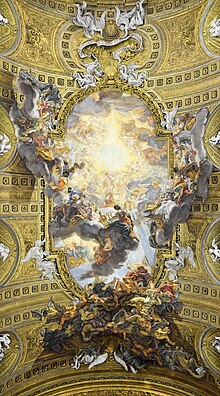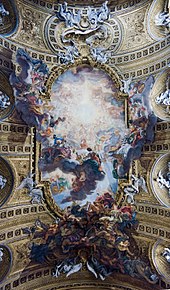| Triumph of the Name of Jesus | |
|---|---|
 | |
| Artist | Giovanni Battista Gaulli |
| Year | 1661–1679 (1661–1679) |
| Type | Ceiling Fresco |
| Location | Il Gesù, Rome |
Triumph of the Name of Jesus is a 17th-century fresco painting by Giovanni Battista Gaulli. The fresco occupies the nave of the Church of the Gesù in Rome, with both fresco painting and stucco molding.
Jesuit history
The Jesuit Order, or Society of Jesus, was formed in 1540, by Ignatius of Loyola. He was wounded during his time as a Spanish viceroy; which led to his religious enlightenment. While their teachings would spread over many countries, the heart of the society was the Il Gesu, built in the late 1600s. Gian Paolo Oliva was the Father general of the Society of Jesus.
Bernini's involvement
Giovanni Battista Gaulli owes a great deal of his success on the ceiling fresco to Gian Lorenzo Bernini. Several other artists were considered for the job of painting the ceiling. Gian Paolo Oliva relied on Bernini's opinion when selecting the artist for the ceiling. Bernini is responsible for not only obtaining the commission for Gaulli, but also for inspiring some of the designs. If not for Bernini's illusionistic merging of architecture and sculpture, in the Ecstasy of Saint Teresa at the Cornaro Chapel in Santa Maria della Vittoria, Gaulli's ceiling fresco may have turned out quite differently. The illusionistic heavens upon the ceiling of the Gesu emphasizes how the church is seen as an intermediary between the mortal world and eternal salvation. Gaulli also enacts a certain level of theatrics to the scene, yet again, similar to that found in the Cornaro Chapel.
Triumph of the Name of Jesus
The subject of Gaulli's ceiling fresco is the Adoration of the Name of Jesus, the story is taken from Saint Paul's Epistle to the Philippians. His words are written on a ribbon, just outside the architectural frame. These words set the scene for Gaulli's fresco and focus on the spreading of faith. The Jesuits wanted to enhance the religious experience, with an almost meditative, emotional peace. The high vaulted ceiling was not constructed merely for its grand and impressive appearance, but to enhance the experience during mass. The Jesuits relied heavily on the acoustics of the church; they wanted their faithful to clearly hear the words of the sermon. This is why the church was constructed with a single nave, and a dome at the nave, transept intersection. One of Gaulli's best innovations is the dramatic breaking of the three-dimensional frame. This gives the impression that the heavenly figures above have a true presence in the church, as if they are floating directly over the viewers' heads. The depth achieved in the fresco extends past the physical ceiling, drawing the blessed upward into the infinite sky. Gaulli adds a pronounced, stucco, frame around his fresco; emphasizing the illusionistic division of the vault's interior and exterior space. When the viewer gazes upon the fresco it is almost impossible to differentiate between fresco and stucco molding. This adds to the illusion of the scene, making it more believable that there are souls ascending and descending in front of the viewer.

There are minute details within the fresco. Gaulli took into consideration the perspective viewers would have, looking up at the ceiling, and painted the saved in an extremely foreshortened fashion to give the false illusion that they were truly floating above the viewers. This draws the viewer in, allowing the viewer's eyes to move upward through the ascending angels. It also tricks the viewer into thinking the fresco has some dimension to it; evoking a sense of spiritual nature. At the apex of the heavenly light there is an almost hidden inscription of IHS, the first three letters of Jesus's name in Greek. This is the only representation of Christ in the ceiling painting. Christ is considered the light of the world; Gaulli took this literally when choosing to depict Christ by his initials and the heavenly light.
Another detail within the fresco is Gaulli's attention to shadowing. The damned fall out of the frame, with the illusion that they are falling into the church. While the heavenly golden light falls upon the saved, “the illusionistic clouds” block this light from the damned; “indicat that the {damned are} destined for eternal damnation.” There is an evident difference between the depicted angels and the damned. Gaulli's angels are flawless creatures; each kissed by the golden light of heaven. The pigment in their clothes, would resonate with the earthly clothes of the viewers. Their faces adoringly look upward towards the light of heaven. Meanwhile, the damned fall from heaven, faces pained, screaming, some too ashamed they look away. Their bodies cast under a dark shadow, while their bodies slowly morph. Some age drastically, while other are transformed into monsters. The damned, outside of the frame, are presented nude, representing the idea that nudity is to be considered shameful.

Gaulli's fresco can be broken up into three different parts. There is the heavenly light and Christ's initials at the center, the arc of clouds the separate the saved from the damned, and the damned figures falling out of the scene. The blessed that rest upon the clouds hang just elbow the frame, giving the illusion that have not yet ascended outside the church into the heavens above. They all still resemble the human form; these qualities give hope to the viewers that salvation is not impossible. The damned greatly contrast that with their corrupted human form. Some of the damned are depicted with wings, claws, and horns. Others are in the process of transforming into hound-like creatures. They have tormented faces, some shielding their faces from the harsh heavenly light. Gaulli has adapted the Triumph of the Name of Jesus to extend both downward to the viewers and upward into the illusionistic heavens, relying on his friend Bernini to influence and inspire one of his greatest works. Illusionistic ceiling paintings began to move in new directions after the completion of this piece. Gaulli's fresco has a complexity to it, making it a work worthy of a High Baroque status.
References
- Citations
- Reichold, Graf, and Wynne, Buildings that Changed the World, 102.
- ^ Reichold, Graf, and Wynne, Buildings that Changed the World, 102.
- Enggass, The Painting of Baciccio, 31.
- Harris, Seventeenth-Century Art and Architecture, 132.
- Held and Posner, 17th and 18th Century Art: Baroque Painting, Sculpture, Architecture, 121.
- ^ Schneider-Adams, Key Monuments of the Baroque, 51.
- ^ Harris, Seventeenth-Century Art and Architecture, 132-133.
- Bailey, Between Renaissance and Baroque: Jesuit Art in Rome, 270
- ^ Enggass, The Painting of Baciccio, 49.
- Waterhouse, Italian Baroque Painting, 70.
- Martin, Baroque, 174
- ^ Enggass, The Painting of Baciccio, 50.
- ^ Enggass, The Painting of Baciccio, 44.
- Enggass, The Painting of Baciccio, 45.
- McComb, The Baroque Painters of Italy: An Introductory Historical Survey, 69.
- Bibliography
- Bailey, Gauvin Alexander. Between Renaissance and Baroque: Jesuit Art in Rome, 1565-1610. Toronto: University of Toronto Press, 2003.
- Enggass, Robert. The Painting of Baciccio. Pennsylvania: Pennsylvania State University Press, 1964.
- Harris, Ann Sutherland. Seventeenth-Century Art and Architecture. London: Laurence King, 2004.
- Held, Julius Samuel and Donald Posner. 17th and 18th Century Art: Baroque Painting, Sculpture, Architecture. New York: H.N. Abrams, 1971.
- Martin, John Rupert. Baroque. New York: Harper and Row, 1977.
- McComb, Arthur K. The Baroque Painters of Italy: An Introductory Historical Survey. Massachusetts: Harvard University Press,1934.
- Reichold, Klaus, Bernhard Graf, and Christopher Wynne. Buildings that Changed the World. New York: Prestel, 1999.
- Schneider-Adams, Laurie. Key Monuments of the Baroque. Colorado: Westview Press, 2000.
- Waterhouse, Ellis Kirkham. Italian Baroque Painting. 2nd ed. London: Phaidon, 1969.